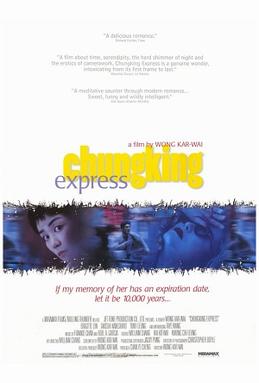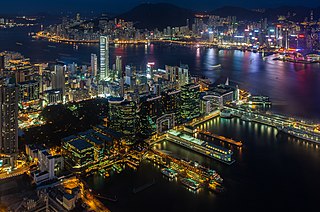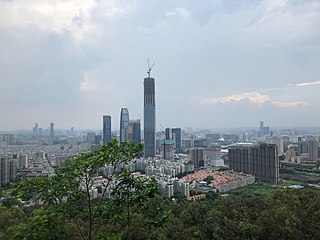
Guangzhou is the capital and largest city of Guangdong province in southern China. Located on the Pearl River about 120 km (75 mi) north-northwest of Hong Kong and 145 km (90 mi) north of Macau, Guangzhou has a history of over 2,200 years and was a major terminus of the Silk Road.

Demographic features of the population of Hong Kong include population density, ethnicity, education level, the health of the populace, religious affiliations, and other aspects.

Demographic features of the population of Macau include population density, ethnicity, education level, health of the populace, economic status, religious affiliations and other aspects of the population.

Chungking Express is a 1994 Hong Kong arthouse romantic comedy-drama film written and directed by Wong Kar-wai. The film consists of two stories told in sequence, each about a lovesick Hong Kong policeman mulling over his relationship with a woman. The first story stars Takeshi Kaneshiro as a cop obsessed by his breakup with a woman named May, and his encounter with a mysterious drug smuggler. The second stars Tony Leung as a police officer roused from his gloom over the loss of his flight attendant girlfriend by the attentions of a quirky snack bar worker.

Tsim Sha Tsui, often abbreviated as TST, is an urban area in southern Kowloon, Hong Kong. The area is administratively part of the Yau Tsim Mong District. Tsim Sha Tsui East is a piece of land reclaimed from the Hung Hom Bay now east of Tsim Sha Tsui. The area is bounded north by Austin Road and in the east by Hong Chong Road and Cheong Wan Road.

Dongguan is a prefecture-level city in central Guangdong Province, China. An important industrial city in the Pearl River Delta, Dongguan borders the provincial capital of Guangzhou to the north, Huizhou to the northeast, Shenzhen to the south, and the Pearl River to the west. It is part of the Pearl River Delta built-up area with more than 65.57 million inhabitants as of the 2020 census spread over nine municipalities across an area of 19,870 square kilometers (7,670 sq mi).

Chater House is an office tower in Central, Hong Kong. Opened in March 2003, it is a part of the Hongkong Land portfolio of properties. It has a three-level retail podium, known as Landmark Chater. The building was built on the site of the former Swire House, and was named after Sir Paul Chater. The building faces streets on three sides: Chater Road, Pedder Street and Connaught Road Central.

The Cantonese people or Yue people, are a Han Chinese subgroup originating from or residing in the provinces of Guangdong and Guangxi, in southern mainland China. In a strict sense, "Cantonese" refers only to people with roots from Guangzhou and its satellite cities and towns, rather than generally referring to the people of the Liangguang region.

World-Wide House is an office building in Central, Hong Kong. It is located between Connaught Road Central, Pedder Street and Des Voeux Road Central.
Refugees in Hong Kong have formed historic waves arriving in the city due to wars in the region and Hong Kong's historical role as a trading and transit entrepôt. More recently those seeking asylum or protection based on torture claims are a fast growing part of the city's population, increasing since 2004 due to changes in the legal system for considering asylum and torture claims mandated by local courts.
Racism in China arises from Chinese history, nationalism, sinicization, and other factors. Racism in the People's Republic of China has been documented in numerous situations. Ethnic tensions have led to numerous incidents in the country such as the Xinjiang conflict, the ongoing internment and state persecution of Uyghurs and other ethnic minorities, the 2010 Tibetan language protest, the 2020 Inner Mongolia protests, discrimination against Africans in particular and discrimination against Black people in general.

The Hong Kong section of the Guangzhou–Shenzhen–Hong Kong Express Rail Link is a 26 km (16 mi) long stretch of high-speed rail that runs along a dedicated underground rail corridor linking Hong Kong to mainland China. It is one of the most expensive infrastructure undertakings in Hong Kong's history. The line connects Kowloon with the high-speed rail network of China at Futian station in the technology hub of Shenzhen, then running north towards the commercial/ political hub of Guangzhou. As of August 2023 the line has an average ridership of 79,000 passengers a day.
The 1918 Shantou earthquake occurred in Shantou, Guangdong, Republic of China. Serious damage and high casualty numbers were reported in Guangdong and the surrounding provinces. It also caused some damage in colonial Hong Kong.
Immigration to the People's Republic of China is the international movement of non-Chinese nationals in order to reside permanently in the country.
Africans in Guangzhou are African immigrants and African Chinese residents of Guangzhou, China.
The community of Nepalis in China consists of Nepalese immigrants and expatriates to China as well as Chinese citizens of Nepalese descent.

Chungking Mansions is a building located at 36–44 Nathan Road in Tsim Sha Tsui, Kowloon, Hong Kong. Though the building was supposed to be residential, it is made up of many independent low-budget hotels, shops and other services. As well as selling to the public, the stalls in the building cater to wholesalers shipping goods to Africa and South Asia. The unusual atmosphere of the building is sometimes compared to that of the former Kowloon Walled City.

Relations between people in Hong Kong and mainland China have been relatively tense since the early 2000s. Various factors have contributed, including different interpretations of the "one country, two systems" principle; policies of the Hong Kong and central governments to encourage mainland visitors to Hong Kong; and the changing economic environment. More broadly, there exists resentment toward mainland-Hong Kong convergence and assimilation, as well as the increasing interference from the government of China and its ruling Chinese Communist Party (CCP) in Hong Kong's internal affairs.

The Guangdong–Hong Kong–Macao Greater Bay Area, commonly as the Greater Bay Area (GBA), is a megalopolis, consisting of nine cities and two special administrative regions in South China. It is envisioned by Chinese government planners as an integrated economic area aimed at taking a leading role globally by 2035.
Locust is an ethnic slur against the Mainland Chinese people in Hong Kong. The derogatory remark is frequently used in protest, social media, and localist publications in Hong Kong, especially when the topics involves the influx of mainland Chinese tourists, immigrants, parallel traders, and the pro-democracy movement.















